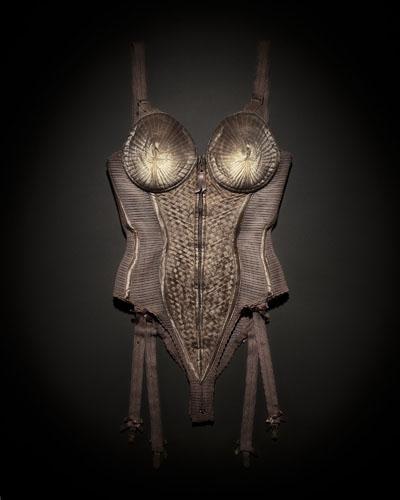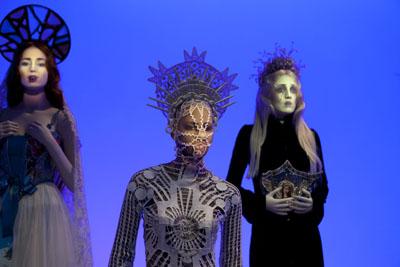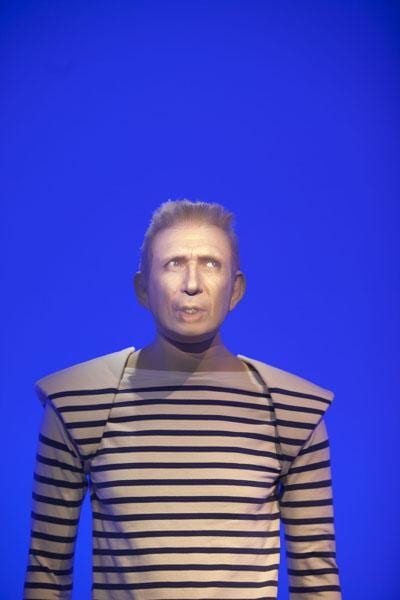
Body corset worn by Madonna, Blond Ambition World Tour, 1990 Credit: Photo by Emil Larsson, courtesy MMFA

Credit: Exhibition photos by Jerry Pigeon/Studio JPG courtesy MMFA

Credit: Exhibition photos by Jerry Pigeon/Studio JPG courtesy MMFA
Evidently Jean Paul Gaultier loves a fabulous rack, too. Last November when I bumped into the iconic fashion designer at the Montreal Museum of Fine Arts (MMFA), I discovered that one of the “artifacts” scheduled for display in the upcoming The Fashion World of Jean Paul Gaultier: From the Sidewalk to the Catwalk was his 1960 teddy bear “Nana.” The piece is complete with the cone bra Gaultier crafted when he was just eight years old.
“You see, I designed the cone bra 30 years before I made one for Madonna,” Gaultier laughs.
The iconic cone-bra body corset Gaultier created for Madonna’s 1990 Blond Ambition Tour is also included in this multimedia exhibition, which is open now and runs to Oct 2. It’s the first international showing devoted to the celebrated French couturier and features 140 ensembles from his couture collections and prêt-à-porter line, dating from 1970 to 2010.
Created and produced by the MMFA to mark the 35th anniversary of the designer’s own label, La maison, Jean Paul Gaultier gave the MMFA exclusive access to its archives.
Gaultier, who granted this reporter a very rare interview, goes out of his way to point out that this exhibition is not a retrospective.
“It is more a contemporary installation,” Gaultier says. “When the director of the Musée des beaux-arts de Montréal, Nathalie Bondil, asked me to participate on this project, I did not want to have a retrospective that would be like a funeral, a chronological presentation. I worked closely two years with the team and curator, Thierry-Maxime Loriot, on the selection of the pieces, on developing the themes that have obsessed me – corsets, skin, cultures, genders, Parisiennes, etc – since I started in the fashion world. It is my story [told] through my clothes.”
This is not your regular fashion exhibition. It really is extraordinarily well put together, from the dazzling layouts, colours and lighting to the pretty darn cool projections that animate the faces of the mannequins. The video masks employ a technique developed 15 years ago by Denis Marleau with UBU, his Montreal theatre company. The masks feature such Montreal performers as Melissa Auf der Maur (formerly of the rock bands Hole and Smashing Pumpkins) and former Montreal models Ève Salvail and Francisco Randez. When their likenesses are projected onto the faces of the mannequins, the mannequins come alive.
Gaultier has always prided himself on being avant-garde and over-the-top. He has, over the years, found many of his muses on the streets of Montreal.
Says Gaultier, “The fashion world can be very formatted when it comes to casting choices and the way models should look. I don’t follow trends. From my very first shows, I did street castings, [using] friends and anybody I thought was interesting. I sell my clothes to real people, not only models. Women are very powerful now, and they can [take responsibility for] what they wear. It is like when Madonna decides to wear a corset; it is like a political statement because she decides to do so. It then becomes a symbol of power and femininity. We dress first for ourselves.”
Gaultier has also been inspired by and worked with many iconic celebrities, including Madonna, Pedro Almodóvar and Leslie Cheung. What, in his estimation, is the common denominator of great stars?
“All the stars I have worked with are very different,” Gaultier replies. “I guess the thing that successful stars have in common is that they work very hard. There is no secret to success, even if you are not a pop singer. Madonna still fascinates me. She has been of great help for this exhibition and the [accompanying] book, loaning pieces from her Blond Ambition Tour and Confessions Tour.”
Another adored Gaultier muse is plus-size pop singer Beth Ditto, of the band The Gossip. Ditto once notoriously complained to London’s NME magazine, “If there’s anyone to blame for size zero, it’s not women. Blame gay men who work in the fashion industry and want these women as dolls. Men don’t know what it feels like to be a woman and be expected to look a particular way.”
“I think everybody is beautiful and has a different kind of beauty,” says Gaultier. “It is always a question of perception and of presentation. Beth Ditto is fascinating by the way she moves and assumes her body. She represents freedom. She comes from a small town in the US, is voluptuous and openly gay. She is very sexy. I have used a lot of plus-size models in my show. They are part of the society, so why not of the fashion world?”
While Gaultier believes women are dressing more for themselves these days rather than for men, he says straight men are also becoming much more style-savvy.
“I think all men should show more their sensitive side, to show more their bodies and shapes,” he explains. “It is not a question of gay or straight. Both can have good and bad taste! I think straight men are getting better with their style. [But] gay men are [still] more aware of what suits them best in some cases, because they have this sensitivity.”
As for his own wardrobe, Gaultier insists he owns nothing extravagant.
“I am not extravagant; I like to dress others,” he explains. “I am more conventional now, but in my personal archives I have a lot [of extravagant outfits], like when I hosted the MTV Europe Awards in 1995 and did 16 costume changes during the show, from a see-through gown with platform boots to a leopard-print Speedo with matching thigh-high boots and maxi fake fur coat. Actually, you can see excerpts of it in the MMFA exhibition.”
Gaultier – whose atelier has lost many employees to AIDS over the last quarter century – tells me sombrely, “Condoms are the most beautiful clothes to wear. AIDS affected a lot my entourage, close friends, coworkers and my partner, who died from it in 1990. I started being involved with AmFar in 1992 when I did a benefit fashion show in LA to fight against this terrible disease. People need to be educated about safer sex. Because even if you can take medications and [can] control it, you still cannot cure it. So awareness is very important.”
Gaultier will be in Montreal for the MMFA and Just for Laughs Festival’s downtown Pinkarnaval parade honouring Gaultier on July 16 (the theme is Gaultier’s signature use of stripes). It’s clear the man loves Montreal, as well as this city’s famed and infamous gay male strip joints, where he has been spotted many times over the years. “It must be my twin brother you saw!” Gaultier laughs.
Then he gets serious, kind of. “I love Montreal because it is like being in Paris, with a bit of New York with its big city feel – but without the Parisians, which is great.”


 Why you can trust Xtra
Why you can trust Xtra


